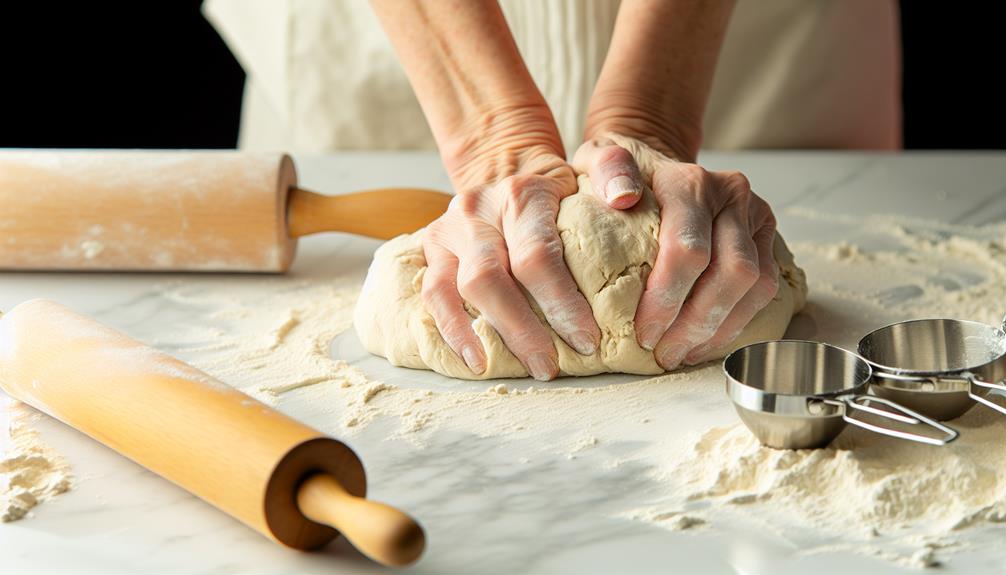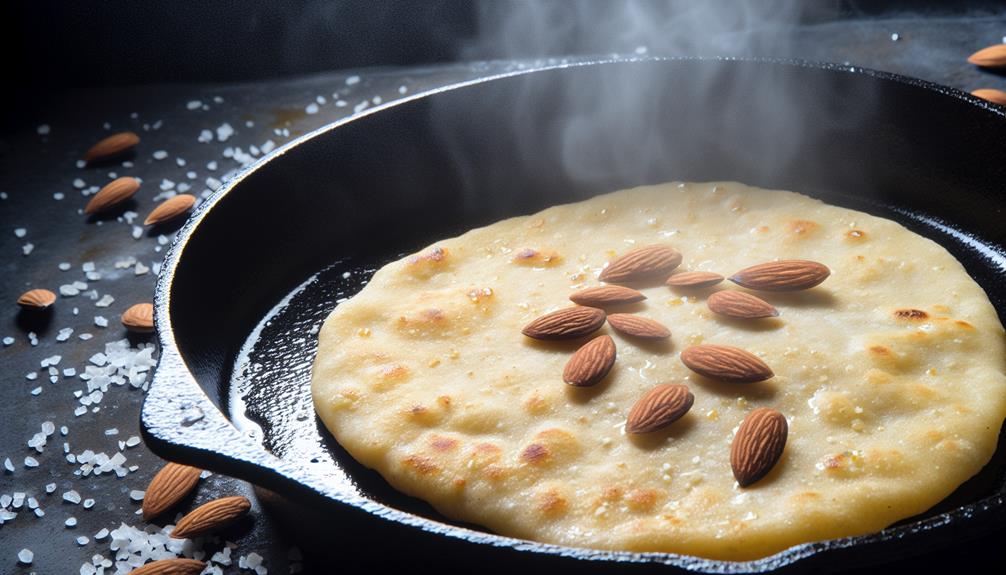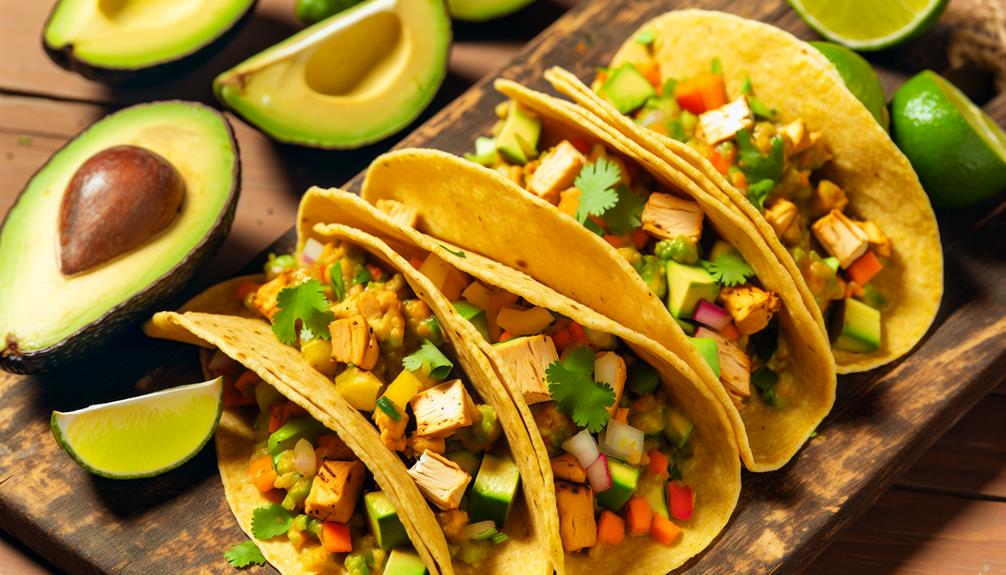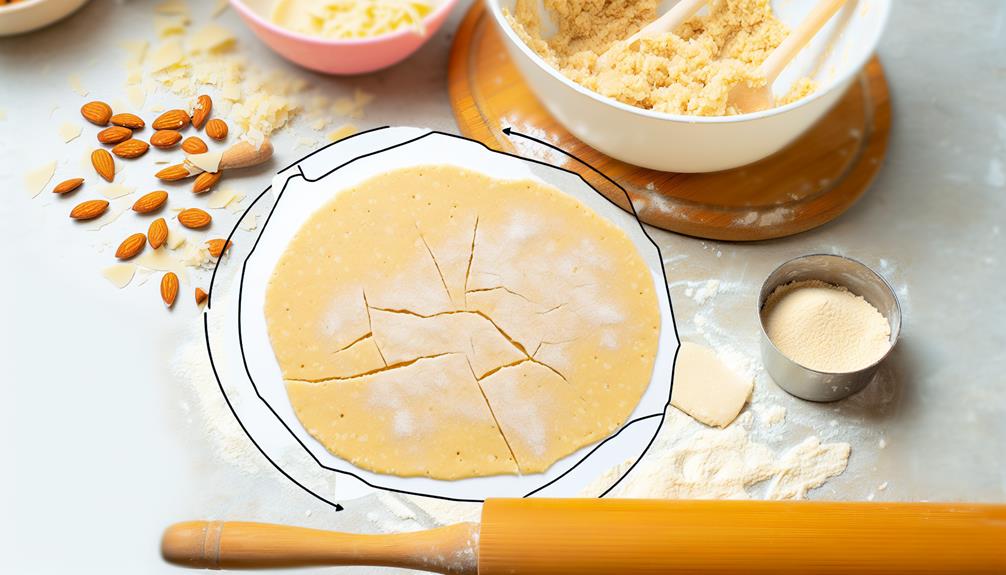To make almond flour tortillas, you'll need almond flour, egg whites, psyllium husk powder, and salt. Mix these ingredients with water to form a pliable dough. After kneading and resting, divide and roll the dough into thin circles. Cook each tortilla for 1-2 minutes per side in a non-stick pan. These low-carb wraps are perfect for keto, paleo, and gluten-free diets. They're rich in healthy fats, fiber, and nutrients, supporting heart health and sustained energy. You can customize them with herbs or protein powders for added flavor and nutrition. Discover how these versatile tortillas can transform your meal planning and dietary goals.
Key Takeaways
- Mix almond flour, salt, egg whites, and water to create a pliable dough, then knead and rest.
- Divide and roll the dough into thin, circular shapes for tortillas.
- Cook tortillas on a non-stick pan for 1-2 minutes per side until lightly browned.
- Store at room temperature for up to 2 days, refrigerate for a week, or freeze for 3 months.
- Experiment with herb-infused variations and serve with protein-rich fillings for a nutritious, low-carb meal.
Ingredients

For this low-carb, gluten-free alternative to traditional tortillas, you'll need almond flour, egg whites, psyllium husk powder, and a pinch of salt. These ingredients work together to create a pliable, nutritious base for your homemade tortillas.
Almond flour, rich in protein and healthy fats, forms the foundation of this recipe. If you're looking for almond flour alternatives, consider using coconut flour or sunflower seed flour for different flavor combinations.
Egg whites act as a binding agent, ensuring your tortillas hold together well. Psyllium husk powder adds fiber and helps achieve the right texture. Don't skip this ingredient, as it's crucial for the tortillas' flexibility. The salt enhances the overall taste, but you can adjust it to suit your preferences.
When selecting ingredients, opt for high-quality, fresh products to ensure the best results. If you're exploring other gluten-free options, you might experiment with cassava flour or a blend of alternative flours.
Equipment Needed
To create these nutritious almond flour tortillas, you'll need a few key pieces of equipment in your kitchen. First and foremost, you'll require a large mixing bowl to combine your almond flour, eggs, and other ingredients. This is where the magic begins, as you'll blend these low-carb components into a cohesive dough.
A rolling pin is essential for achieving the perfect thickness in your tortillas. You'll use it to flatten the dough into thin, circular shapes that'll cook evenly and fold easily around your favorite fillings.
| Equipment | Purpose | Emotional Impact |
|---|---|---|
| Mixing bowl | Combines ingredients | Excitement of creation |
| Rolling pin | Flattens dough | Satisfaction of craftsmanship |
| Non-stick pan | Cooks tortillas | Anticipation of flavor |
Don't forget a non-stick pan for cooking your tortillas. This ensures they won't stick and tear, preserving their integrity for your health-conscious meals. You'll also need measuring cups and spoons for precise ingredient ratios, crucial for maintaining the right macronutrient balance. A spatula will help you flip the tortillas as they cook, and a clean kitchen towel will keep them warm and pliable until serving time. With these tools, you're ready to serve up delicious, grain-free tortillas to your loved ones.
Preparing the Dough

Now that you've gathered your equipment, it's time to dive into the heart of making almond flour tortillas: preparing the dough. Begin by combining your almond flour, a low-carb alternative rich in healthy fats and protein, with a pinch of salt in a medium-sized bowl.
In a separate container, whisk together egg whites and water, creating a protein-packed binding agent that'll help achieve the perfect dough consistency. Incorporate the wet ingredients into the dry mix using gentle folding motions. As you blend, pay attention to the dough's hydration level. You're aiming for a slightly sticky yet manageable texture.
Once combined, employ kneading methods to develop the dough's structure. Use your fingertips to press and fold the mixture, working it for about 2-3 minutes. After kneading, allow the dough a resting period of 10-15 minutes. This crucial step lets the almond flour absorb moisture, resulting in a more pliable dough.
Cover the bowl with a damp cloth to prevent drying. Once rested, your dough is ready for shaping and cooking, setting the stage for delicious, nutrient-dense tortillas that'll nourish those you're serving.
Shaping the Tortillas
The art of shaping almond flour tortillas requires precision and a gentle touch to achieve thin, pliable rounds that'll complement your low-carb meals. Begin by dividing your prepared dough into equal portions, roughly the size of golf balls. Place each portion between two sheets of parchment paper to prevent sticking.
Using a rolling pin, gently apply pressure from the center outward, employing circular motions to create an even thickness. Aim for a diameter of about 6-8 inches, ensuring the edges aren't too thin. If you're serving those with specific dietary needs, consider cutting shapes like triangles or squares for variety.
When it comes to flipping methods, carefully peel off the top parchment layer and use a thin spatula to transfer the tortilla to a preheated skillet. Cook for 1-2 minutes on each side until golden brown spots appear.
For folding styles, allow the tortillas to cool slightly before gently folding them in half or quarters. This'll help maintain their shape for serving tacos or wraps.
Cooking Methods

Now that you've shaped your almond flour tortillas, it's time to cook them to perfection.
You've got three main options: stovetop skillet cooking for a traditional approach, oven baking for a hands-off method, or using an air fryer for a quick and crispy result.
Each technique offers unique benefits, so choose the one that best fits your kitchen setup and desired texture.
Stovetop Skillet Cooking
Stovetop skillet cooking offers a quick and efficient method to prepare your low-carb, gluten-free almond flour tortillas with precise heat control. This technique allows you to achieve the perfect balance of crispiness and pliability, catering to various texture preferences.
To enhance the flavor combinations, consider these cooking tips:
- Preheat your skillet over medium heat for even cooking
- Use a non-stick pan or lightly grease with coconut oil for easy flipping
- Cook each tortilla for 1-2 minutes per side, or until golden brown spots appear
By mastering these time-saving hacks, you'll be able to serve up a batch of delicious almond flour tortillas in no time. Remember to adjust the cooking time based on your desired texture – shorter for softer tortillas, longer for crispier ones.
As you prepare these tortillas for others, keep in mind their dietary needs and preferences. Almond flour tortillas are an excellent option for those following keto, paleo, or gluten-free diets. They're rich in healthy fats and protein, making them a nutritious alternative to traditional wheat-based tortillas.
Experiment with different seasonings to create unique flavor profiles that will delight your guests and make your meals more memorable.
Oven Baking Method
While stovetop cooking offers speed, oven baking provides a hands-off approach to preparing your almond flour tortillas, allowing for consistent results and the option to make larger batches.
To oven-bake your tortillas, preheat your oven to 350°F (175°C) and line a baking sheet with parchment paper. Shape your almond flour dough into thin, round discs and place them on the prepared sheet.
For those seeking flavor variations, consider adding herbs like rosemary or thyme to your dough. You can also experiment with seasoning options such as garlic powder or smoked paprika for a savory twist.
Bake the tortillas for 8-10 minutes, flipping halfway through for even cooking. Keep an eye on them to achieve your desired texture preferences; longer baking times will result in crispier tortillas.
One of the key baking tips is to ensure your tortillas are evenly thick to promote uniform cooking. If you're serving others with specific dietary needs, you can easily adjust the recipe by incorporating alternative flours or adding protein powder to boost the macro profile.
Air Fryer Technique
If you're looking for a quick and efficient way to cook your almond flour tortillas, the air fryer offers a fantastic alternative that's both time-saving and health-conscious. This method allows you to achieve a perfect balance between crispy and soft textures, depending on your preference.
When using an air fryer, remember that tortilla thickness plays a crucial role in determining cooking times and final texture.
Here are three key points to consider when air frying your almond flour tortillas:
- Temperature: Set your air fryer to 350°F (175°C) for optimal results.
- Cooking time: Start with 2-3 minutes per side, adjusting as needed.
- Batch size: Cook in single layers, avoiding overcrowding for even cooking.
For those seeking air fryer alternatives, you can experiment with different settings to achieve your desired outcome. If you prefer a crispier texture, increase the cooking time slightly or raise the temperature. For softer tortillas, reduce the time or lower the temperature.
Storage Tips
To maintain the freshness and texture of your low-carb almond flour tortillas, you'll want to store them properly. These keto-friendly wraps can be kept at room temperature, refrigerated, or frozen, depending on how quickly you plan to use them.
For short-term storage, keep your tortillas in an airtight container at room temperature for up to 2 days. If you need them to last longer, refrigeration is your best bet. Place them in a sealed bag or container, separating each tortilla with parchment paper to prevent sticking. They'll stay fresh for up to a week in the fridge.
For long-term storage, freezing is an excellent option. Here's a quick guide to freezing options and shelf life:
| Storage Method | Packaging | Shelf Life | Thawing Tips |
|---|---|---|---|
| Room Temp | Airtight container | 2 days | N/A |
| Refrigerated | Sealed bag/container | 1 week | 30 min at room temp |
| Frozen | Freezer bag | 3 months | Overnight in fridge |
When freezing, wrap each tortilla individually in plastic wrap before placing them in a freezer bag. This proper packaging prevents freezer burn and maintains quality. To serve, simply thaw overnight in the refrigerator or for 30 minutes at room temperature.
Serving Suggestions

Now that you've mastered making almond flour tortillas, let's explore some serving ideas to maximize their versatility.
You'll find these low-carb alternatives pair well with various dishes, from classic Mexican fare to more innovative fusion cuisine.
Consider topping your tortillas with protein-rich fillings like grilled chicken or fish, or load them up with colorful, nutrient-dense vegetables for a satisfying, macro-balanced meal.
Meal Pairings
Almond flour tortillas frequently pair well with protein-rich fillings to create balanced, low-carb meals that'll keep you satiated. Consider combining them with grilled chicken breast, avocado, and a sprinkle of feta cheese for a Mediterranean-inspired wrap.
For a vegetarian option, stuff them with black beans, roasted vegetables, and a dollop of Greek yogurt. These tortillas also make excellent vessels for breakfast burritos filled with scrambled eggs, spinach, and turkey bacon.
When it comes to flavor pairings, think about complementing the nutty taste of almond flour with:
- Smoky spices like cumin and paprika
- Fresh herbs such as cilantro or basil
- Tangy ingredients like lime juice or pickled onions
For presentation ideas, serve your almond flour tortilla creations on a rustic wooden board or colorful ceramic plate. If you're hosting a dinner party, consider offering a build-your-own taco bar with various fillings and toppings.
As for wine pairings, a crisp Sauvignon Blanc or light Pinot Noir can complement the subtle nuttiness of the tortillas. For dessert options, try filling them with Greek yogurt and fresh berries for a healthier twist on crepes.
Toppings and Fillings
Elevating your almond flour tortillas with the right toppings and fillings can transform them into nutrient-dense, satisfying meals that cater to various dietary needs. Consider flavor combinations that balance protein, healthy fats, and complex carbohydrates.
For a savory option, try grilled chicken with avocado, cilantro, and a squeeze of lime. Vegetarians might enjoy black beans, roasted sweet potatoes, and a sprinkle of pumpkin seeds for added crunch.
Presentation ideas can make your tortillas more appealing. Roll them into wraps, fold them into tacos, or layer them for a stacked enchilada-style dish. Texture preferences play a crucial role in enjoyment, so mix soft ingredients like hummus with crisp vegetables like bell peppers and cucumbers.
Don't forget to incorporate seasonal variations to keep your meals exciting and nutritious year-round. In summer, opt for fresh tomatoes and corn salsa, while autumn calls for roasted butternut squash and sage. Winter might feature warm, spiced lentils, and spring could showcase tender asparagus and pea shoots.
Nutritional Benefits
These protein-packed tortillas offer a low-carb alternative to traditional wheat-based options, making them ideal for keto and gluten-free diets. Almond flour tortillas boast numerous health benefits and unique flavor profiles that'll enhance your meals. They're rich in vitamin E, magnesium, and healthy fats, supporting heart health and providing sustained energy.
You'll appreciate the versatility of these tortillas, as they offer various texture options depending on your preparation method. Whether you prefer them soft and pliable or crispy and chip-like, you can adapt them to suit your needs.
Here are three creative recipes to try:
- Breakfast burrito with scrambled eggs and avocado
- Fish tacos with mango salsa and cilantro lime slaw
- Dessert quesadilla with almond butter and banana
Troubleshooting Common Issues

When making almond flour tortillas, you might encounter issues with cracking or breaking. To prevent this, ensure your dough has the right moisture content and consider adding a binding agent like xanthan gum.
You'll achieve the proper texture by rolling the dough thin and cooking the tortillas on medium heat, flipping them once they start to bubble.
Preventing Cracking and Breaking
Cracking and breaking can be common frustrations when making almond flour tortillas, but you'll avoid these issues by maintaining proper moisture balance and handling techniques. When working with gluten-free options like almond flour, moisture control is crucial. Add just enough liquid to form a pliable dough, but not so much that it becomes sticky. If your dough feels dry, incorporate a small amount of water or oil gradually.
Rolling techniques play a significant role in preventing cracks. Use a light touch and roll the dough between two pieces of parchment paper to maintain an even thickness. This method also helps with flour alternatives that can be more delicate than traditional wheat flour.
To further prevent cracking and breaking, consider these tips:
- Let the dough rest for 10-15 minutes before rolling to allow the flour to fully absorb the moisture.
- Cook the tortillas on medium-low heat to ensure they're cooked through without becoming brittle.
- Store them properly by stacking with parchment paper between each tortilla to prevent sticking and maintain moisture.
Achieving Proper Texture
While preventing cracks is important, achieving the right texture in your almond flour tortillas can be equally challenging. You'll want to focus on creating a soft, pliable consistency that doesn't become too crisp or brittle when cooked. To achieve the ideal texture consistency and flavor balance, pay close attention to your ingredient ratios and cooking time.
Start by ensuring your almond flour is finely ground. If it's too coarse, your tortillas may end up gritty. You can also experiment with ingredient substitutes like adding a small amount of tapioca or arrowroot starch to improve elasticity. When mixing your dough, aim for a smooth, slightly sticky texture that's not too wet or dry.
As for cooking, keep a close eye on your tortillas. Overcooking can lead to a crisp, cracker-like texture, while undercooking may result in a doughy center. Aim for a light golden color with small brown spots. Remember, cooking time may vary depending on your pan's heat and the tortilla's thickness.
Variations and Add-ins
Several delicious variations and nutrient-boosting add-ins can transform your basic almond flour tortillas into custom, macro-friendly creations. By experimenting with flavor combinations and customized fillings, you'll discover unique twists that cater to various dietary needs and preferences.
To elevate your almond flour tortillas, consider these creative presentations and add-ins:
- Herb-infused: Mix in finely chopped fresh herbs like basil, cilantro, or rosemary to enhance flavor and provide antioxidants.
- Protein-packed: Incorporate unflavored protein powder or ground flaxseed for an extra protein and fiber boost.
- Colorful nutrient boost: Add powdered beetroot, spinach, or turmeric for vibrant hues and additional micronutrients.
These variations not only improve the nutritional profile but also offer exciting taste experiences. You can tailor your tortillas to complement specific dishes or dietary requirements, making them perfect for serving others with diverse needs.
Conclusion
You've mastered the art of almond flour tortillas! They're low-carb, gluten-free, and packed with protein. You'll enjoy their nutty flavor and versatile nature. Use them for wraps, tacos, or quesadillas. They're keto-friendly, paleo-approved, and perfect for those watching their macros.
Remember, practice makes perfect. Experiment with add-ins, adjust cooking times, and find your ideal texture. With these tortillas, you're not just eating healthier—you're revolutionizing your approach to grain-free dining.